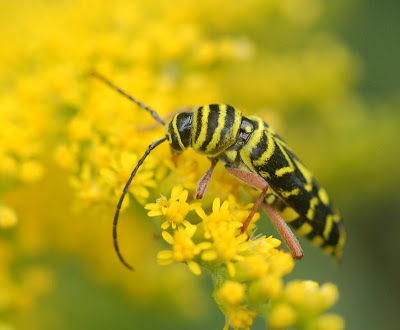
At the end of every summer, these handsome Locust Borers hit the goldenrod around here, eating pollen and meeting members of the opposite sex. They make such a pretty picture, and I can never resist grabbing a few, gripping them gently by the abdomen and listening to them "squeak." Like many other cerambycid beetles, Megacyllene robiniae individuals stridulate when disturbed. Our ridge was under cultivation until the 1950's and black locust is well-represented among our early successional species. It makes excellent firewood whether or not it has been infested with these long-horned beetles.
I found an excellent online "leaflet," The Locust Borer: Forest Insect & Disease Leaflet 71 from the U.S. Department of Agriculture Forest Service. Here's an excerpt:
The locust borer, Megacyllene robiniae (Forst.), is a native insect. Its original range probably coincided with that of its host tree, the black locust, which once grew only along the Allegheny Mountains from Pennsylvania to Georgia and in the Ozark Mountain region.
Black locust grows readily on poor sites and is used extensively in land-reclamation plantings. Its widespread use to reclaim land damaged by farming and strip mining, its use as a shade tree, and its use in reforestation have dispersed the borer with its host tree over most of the United States. The borer is now found from eastern Canada south to the Gulf States and west to Washington, Colorado, and Arizona.
The borer attacks only black locust (Robinia pseudoacacia L.) and its cultivars (horticulturally derived varieties in the genus Robinia); the honey locust (Gleditsia triacanthos L.) is not affected....
The conspicuous, brightly colored adults appear when goldenrod (Solidago sp.) is in bloom. Adults are most abundant during September, when they are commonly found feeding on pollen of goldenrod blossoms.
Egg laying occurs from early afternoon until late evening from late August through early October. The females lay eggs prolifically under bark scales, in callus tissue around pruning wounds, in cracks in the bark, and in other hiding places. The eggs are rarely laid where they can be seen.
In about a week, the eggs hatch and small, white larvae bore into the inner bark. Each larva makes a small hibernation cell and overwinters there. In the spring when the leaf buds begin to swell, the larvae begin to bore into the woody part of the tree, causing sap to ooze around small holes. Throughout the spring and early summer, the larvae enlarge their tunnels until they are 3 to 4 inches (7.6-10.2 cm) long and about one-quarter of an inch (0.6 cm) in diameter.
By mid-July, most of the larvae have matured and transformed into the pupal stage, which is completed between the end of July and the first 2 weeks of August. Mature beetles emerge from the trees through the openings made by the larvae.

2 comments:
Thanks for your fine photographs of this beetle, Rebecca! Here in Hannibal black locust trees are even more common than ailanthus and I'm sure that the locust borer lives here. I'll keep an eye out for this insect on my walks during this goldenrod blooming season, which has another month or so before the first frosts.
I expect you'll find some--don't forget to make them squeak! (Small things amuse me.)
Post a Comment